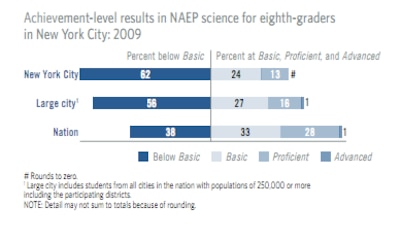
New York City fourth graders did about as poorly on a national science test in 2009 as those in other large American cities, but the city’s eighth graders lag behind their peers.
More than 60 percent of city eighth graders scored below basic on the National Assessment of Educational Progress science exams. Nationally, 38 percent of students scored below the basic level, and 56 percent of students in large city school districts did not meet that bar.
The city’s fourth graders fared better. Still, 44 percent scored below basic on the science tests. In other large cities, roughly the same percentage of students didn’t score above the “basic” bar.
The Department of Education’s Chief Academic Officer, Shael Polakow-Suransky, said that the city was focusing on introducing national “Common Core” standards into classrooms as a strategy to boost achievement in science. The standards include a focus on reading and writing non-fiction and technical texts in subjects like science.
“The gap between how our students perform in elementary and middle school is a real concern, which is why it’s crucial that we continue working toward the tougher Common Core Standards as quickly as possible,” Polakow-Suransky said. “That gap can be closed if we build literacy skills in science, as these new standards do, and prepare our kids for the critical thinking and problem solving they begin to face in middle school.”
A sampling of fourth, eighth and twelfth graders around the country take the NAEP exams every two years. NAEP scores are usually reported by state, but in 2002 several large cities including New York agreed to have their own figures reported separately.
Of the 17 city school districts whose results were reported today, New York City ranked seventh in fourth grade test results and eighth in eighth grade scores. Austin, Charlotte, Jefferson County, Ky., Miami-Dade, San Diego and Boston all bested New York City in both grade levels. On the eighth grade exams, Houston also performed better than New York.
Overall, New York City’s fourth-grade science scores were lower than the national average. But when the scores are broken down by ethnicity and poverty level, each of New York’s subgroups performed about the same on average as their peers nationally. (So for example, black fourth graders in New York City performed about the same as the national average for black students in that grade.)
The city’s eighth graders, by contrast, received lower scores than their peers nationally across all demographics except Asian students.
The results also indicate that fewer city students are doing well in science than in reading and math. More than 60 percent of the city’s eighth graders scored either basic, proficient or advanced in both reading and math in 2009.
The same was true across all of the large urban districts on average. U.S. Education Secretary Arne Duncan called on cities to improve their science education.
“The results released today show that students in our cities are further behind in science than in reading and mathematics,” Duncan said in a statement. “With 44 percent of fourth graders and 56 percent of eighth graders scoring below NAEP’s basic level, these results show that large city districts aren’t preparing enough students to succeed in the knowledge economy.”
In 2009, the science exams were overhauled, which means that the new results cannot be compared to previous years’ to track progress, the exam’s administrators said.
The new science exams cover three content areas: physical, life, and earth and space sciences. Unlike earlier NAEP exams, questions “crosscut” the subjects so that a question about one content area also relies on knowledge from one or both of the others.
